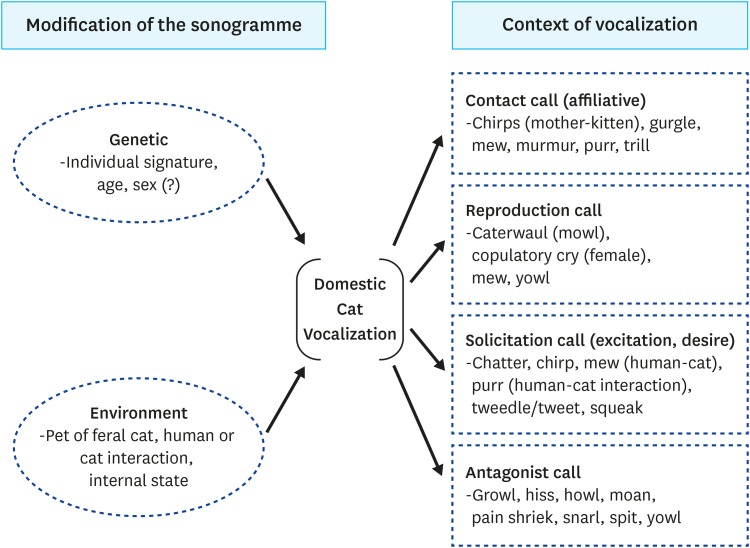Abstract
Cat vocalizes to communicate with another and express their internal states. The vocal repertoire of the cat is wide and up to 21 different vocalizations have been described in the literatures. But it is more than probable that the repertoire contains more types of vocalizations. An ethogram was created in this paper describing the actual known vocalisations of the domestic cat based on an auditory classification. However, the audiogram allows also a visual classification which can increase the accuracy of vocalization differentiation. The classification can be risky as it is sometimes unclear if different types of vocalizations are produced in different environments or if a unique type of vocalization is used with variation in the acoustic parameters. As an example, isolation calls produced by kittens differ depending on the context. The environment has an important impact on the vocal behaviour and thus feral cats and pet cats vocalize differently. Pet cats are thus able to create an efficient communication with humans thanks to the flexibility of vocalisation behaviours. This review allowed us to create a simple model of the cat vocal repertory.
Keywords: Animal vocalization, cat, auditory perception
INTRODUCTION
The domestic cat (Felis silvestris catus) is one of the most common domestic animals nowadays with around 600 million individuals in the world [1]. The communication system of cats is wide, and specific messages can be transmitted using several sensory modalities like visual, olfactory or auditory signals [2,3]. One particularity of the domestic cat is that it has been described as having a more developed and complex vocal repertoire than any other member of the carnivora and is even more vocal than its wild counterpart, the Felis silvestris lybica [4,5]. This is a surprising finding, especially as one would predict that small prey like the cat would tend to vocalize less to prevent localization by a predator [2]. At the present time, research about cat vocalization is sparse and in the popular mind few facts are known about cat vocalization. The present paper aims thus to summarize the knowledge on those behaviors in order to help future research by stating what is known (chapter: vocal classification) and what is still to be understood (chapter: future research and conclusion). We also aimed to give the situations in which vocalization is produced (chapter: context of vocal production) and how those situations can influence the vocal production. To compare with other reviews that might already be published, this one will explore both qualitative and quantitative acoustic research of the domestic cat vocalization [3,6]. By creating a clear ethogram of the known cat vocalizations (Table 1), it will also be possible to show the unknown or controversial behaviors.
Table 1. Ethogram of the adult cat vocalization.
| Vocalization | Definition | Context | Mouth | Spectrogram | Reference |
|---|---|---|---|---|---|
| Caterwaul or mowl | Loud, drawn out whine, variable pitch. May be like the yowl | Male: reproductive female: warning | [3,5] | ||
| Chatter | Cat rhythmically clashes the jaws, creating a low-amplitude, smacking sound. Mostly voiceless | When desiring prey which is out of reach: displacement | + | 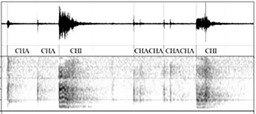 |
[3,5,8] |
| Chirp | A short, high-pitched call described as similar to a bird chirping. Sequence of chirps are labeled chirrups | Contact call: used to locate conspecifics; when something is desired | + | 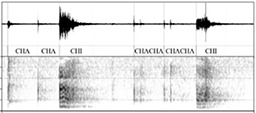 |
[3,5,8,53] |
| Female: produced in or in approach to the nest | |||||
| Copulatory cry | Cry emitted by female cat during successful intromission. Low, barely audible growl | Reproductive (female) | + | [3,43] | |
| Growl | A graded, low-pitched, throaty, rumbling noise | Aggressive: agonistic. Mainly used to signal danger or to warn or scare off an opponent | Slightly open or closed | 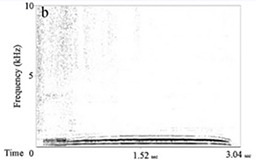 |
[3,5,9,11,12,15] |
| Gurgle | Short, coherent, pulsed sound described as similar to a person gargling their throat. Largely atonal sounds of low intensity | Affiliative: friendly; females with kittens | 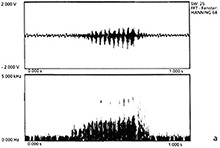 |
[3,14] | |
| Hiss | A drawn-out, low-intensity hissing sound produced by rapid expulsion of air from the cat's mouth, usually during exhalation | Agonistic; involuntary reaction to when a cat is surprised by an apparent enemy | + | 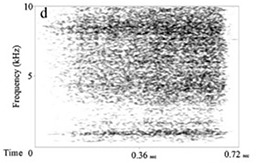 |
[3,5,15,29,35] |
| Howl | Tonal sounds, distinguished from yowls in that howls are typically shorter in duration | Agonistic threatening or defensive responses | + | 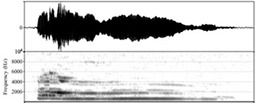 |
[5,9] |
| Mew (meow, miaow) | The distinctive “meow” call that is typical of cat | Many (social, reproduction, contact call) | Open and closed gradually |  |
[5,7,12,15,29,30,31,36,41,49] |
| Moan | Long, often slowly frequency-modulated vowel sounds or “o” or “u” | Aggressive: agonistic. Mainly used to signal danger or to warn or scare off an opponent | Open and closed gradually | [5,29] | |
| Murmur | Short, soft-voiced trill or purr, sounding like [mhrn] or a creak | Friendly approach and play | − | 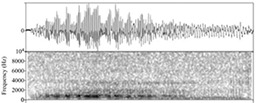 |
[5,29] |
| Pain shriek | Short intense cries of tense vowels that are characterized by great strain at mouth and throat and the force of breath | Active fighting | + | [9] | |
| Purr | Low, continuous rhythmical tone produced during respiration. Creates a murmuring sound. | Friendly: contentment. Signal: “I am not a threat” | − | 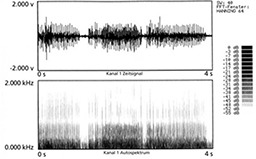 |
[2,3,5,11,16,29,31,39,42,53] |
| Solicitation: human-cat interaction | |||||
| Trills | Garnishments, produced with a soft voice like the purr | Greeting call | − | [44] | |
| Tweedle | Prolonged chirp or tweet often with some voice modulation | When something is desired | + | 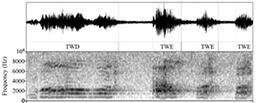 |
[8] |
| Tweet | Soft weak chirps, often without any clear initial [Ɂ] and with varying vowel qualities, e.g. [wi] or [ɦɛu] | When something is desired | + | 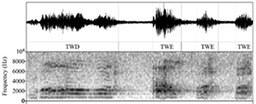 |
[8] |
| Snarl | Cat bares teeth while emitting a sound similar to a growl, but the sound is usually louder, shorter and higher in pitch than a growl. | Aggressive: agonistic | + | 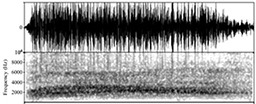 |
[3,9,29] |
| Squeak | Raspy nasal high-pitched mew-like call | Play and anticipation of feeding | + | [5,13] | |
| Spit | Cat makes a sudden, short, explosive exhalation resulting in a burst of noise that is often accompanied by a violent movement | Aggressive | + | 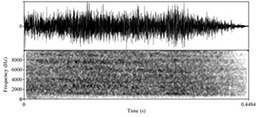 |
[3,5,9,11,29] |
| Yowl | A long, drawn-out vocalization of variable pitch, intensity, duration and tonality | Reproductive; mild threat | + | [2,3,5,9,29,31] |
CHA, chatter; CHI, chirps; TWD, tweedle; TWE, tweet.
The source-filter theory defines a vocal production by the respiratory airstream from the lung passing by the larynx involving the vocal fold (source) and then the supra-laryngeal vocal tract (filter) [7]. However, in the case of the cat, researchers have defined behaviors considered “voiceless” (chatter, hiss, and spits) as vocalization [8,9]. Vocalization are a good tool to express the internal state and emotions, there is a tight integration with brain centers of emotional control [10]. Thus, vocalization is a useful emotional scale that might be used by veterinarians and cat owners. However, to avoid misinterpretation, it is important to have an actual good knowledge of those vocalizations.
It has long been agreed that felids possess 12 vocalization types and that this communication system is not used to transmit specific messages [2,11]. Comparing the cat with the dog, the cat is said to have been less affected by domestication and to show less interspecific flexibility [12,13]. Even if the vocalizations produced by cats are less frequently produced in comparison to other communication modalities, this review aims to show their diversity [3]. Also, when looking at each specific vocalization type, a high intraspecific variation is displayed in the intensity, duration, and pitch or tonality [11]. Thus, it is sometimes hard to categorize a specific vocalization. To counter this limitation another type of categorization has been proposed based on the visual description of the spectrogram. Cats are known to use vocal communication in 3 interactions, “mother/youth”, “agonistic” and “sexual”, but, despite the widespread belief that cats are solitary, they actually can have an important social life and thus use specific vocalizations for this context [12,14,15]. To those general interactions, it is also important to add the “cat/human” interaction, as cat domestication might have taken place as long as 10,000 years ago [16].
AUDITORY PERCEPTION
A study on animal auditory perception has compared audiograms of several different animals and found out that cats are the most sensitive mammals tested in this study, which means that cats are able to perceive weak sounds [17]. The hearing range for cats is limited from 63 kHz for the lowest frequency, to 79 kHz for the highest frequency. Which means that cats can hear in the (human) ultrasonic range [5,17]. The ultrasound, based on the human hearing range, is defined as a sound that has a frequency greater than 20 kHz. In addition, the cat is one of the most accurate sound localizers [17]. The primary auditory cortex of the cat is essential for sound localization and is essential to provide a neural representation of the acoustic parameters [18,19]. The study from Zhao et al. [19] has shown that sounds create a response in the amygdala and medial prefrontal cortex which have an important role in emotion and learning. As an example, it has been shown that cats can learn to recognize their names [20]. However, it is still unknown how these two structures are involved in sound discrimination and if their mechanisms differ from the neurons of the auditory cortex.
VOCALIZATION PRODUCTION
Most of the cat vocalizations are produced by oscillation of the vocal folds during exhalation or even inhalation (purr) [11]. The cat uses several mechanisms to produce sounds [21]. The cat vocal repertoire was described by Moelk [22] as being indefinitely wide in sound and pattern in variation. The complex repertoire can be explained by the specific lifestyle of the domestic cat through its social organization that is based on female lineages and affiliative relationships. Cat social colonies are complexes and they are able to recognize between individual of the colony and outsiders [23]. Other factors inducing the large vocal repertory of cats is its nocturnal activity and the long period of association between the mother and her young [4]. Those variations can be influenced by several parameters. There are external factors such as the rearing environment that can influence perceptual ability in later life and environmental circumstance that can elicit divergent sound production [24,25].
As internal factors, the first one to consider would be physiologic. For example, vocalization rate varies depending with the age [25]. Also, the intentions of the emitter are expressed in the vocalization. The modification of the acoustic parameters (duration, source, tonality, or fundamental frequency [Fo]) would allow a change of the message that represents the cat's internal conditions during an agonistic encounter or isolation [7,26]. The agonistic sounds are described as aggressive or defensive sounds used to warn, shock, or startle an intruder or attacker [9]. The isolation sounds would be emitted by kitten when the mother or littermates are gone. The cat would thus produce a sound adapted to its internal state (aggression or fear) and the context. For example, a high arousal condition would trigger a call with longer duration, shorter inter-call interval with a lower Fo and lower tonality values than in a low arousal condition [7].
An intention not directly linked to the internal state is the production of sounds said to attract prey by copying their calls [8]. It is not sure that why cat chatter. It was known that it's triggered by excitement and resemble of bird's vocalization. It seems that cats are able to elicit sounds when their attention is caught by an insect or a bird. Those vocalizations can be voiceless (chatter) or not (tweet and tweedle) and in that last case an inter-cat variation was noticed [8]. The identity of the sender is contained within the call. For every kind of vocalization, there is an inter-individual variation [7,8].
VOCAL CLASSIFICATION
The literature was selected by searching a large pool of potentially relevant articles. The keywords selected were “cat” and “vocalization”. “Feline” keyword was also selected as some articles state and compare the vocalization of different cat species. Also, vocalizations of F. s. lybica (wild cat) were included in the present study as the vocalization of the two subspecies might be close [27]. Four articles [8,9,28,29] are included in the present review as they are good description of vocalization types, however sample numbers of the pilot studies are low (between 3 and 4 individuals) and that should be considered while looking at the data.
Cat vocalizations are wide and flexible in their parameters. Cats can produce very loud sounds such as the meow, but also very quiet ones such as the chirp [8,30]. Vocalization can be combined, repeated or even produced at the same time to create phrases that vary in complexity [8]. Each vocalization type is described below and, when the data were available, the parameters of the different sounds are given. If several data sources were gathered for a unique vocal type, all of the references are included in this review to give the reader a more appropriate description of the vocalization instead of selecting a unique data source. A summary of the adult cat vocal ethogram is detailed in the Table 1 with an example of the spectrogram of each call, when it was available; however, only one example of the spectrogram was given even if several exist in the literature.
Traditionally, adult cats possess 12 different kinds of vocalizations, however, after reviewing the literature it seems that more vocalizations may have been identified meaning that cats can produce more vocalizations than the ones described below.
Call
The call vocalization was not included in Table 1 as it was too broadly used in the literature. It could refer to a “meow” as well as any other kind of vocalization. Thus, calls can have various functions as it could serve to express a state resulting from a general motivation stage but is specific to an emitter-perceiver couple [2,31].
Chatter
The chatter vocalization refers to teeth chattering produced by the cat in a vicinity of prey. The sound is the result of a quick stuttering or clicking sound with the jaw and a tensely open mouth. Often produced in sequences, the phrases could include other types of vocalization, or chatters of varying intonation. The sound of the chatter is often voiceless, meaning that it is produced without vibration of the vocal cords.
Schötz [29] described the chatter as mostly voiceless but published data of the chatter parameter the year before (duration [sec]: 0.74; minFo [Hz]: 130; maxFo [Hz]: 903; meanFo [Hz]: 580; number of cats: 3). The data must be taken carefully, however, as it might actually not refer to chatter but to chirping [8].
Chirp
Chirps were described by Feuerstein and Terkel [32] as high-pitched sound with a rise of the tone near the end of the vocalization. The short sound was named as it could be mimicking bird or rodent chirp. This sound can be produced either as a single sound or repeatedly. The latter leads to a sequence of chirps labeled chirrups and the chirp's parameters are as followed: duration (sec): 0.15; minFo (Hz): 223; maxFo (Hz): 1,190; meanFo (Hz) (standard deviation [SD]): 661 (194); number of cats: 3 [8]. The chirp sounds can vary in intonation as much as the other vocalizations, either inter-individually or intra-individually. The chirp is also a vocalization used in the nest and this specific function is thus described in the kitten-mother interactions chapter.
Growl
Schötz [9] describes the growl as a guttural, harsh sound. It is regularly and rapidly pulse-modulated, with a long duration. Its parameters are as follows: duration (sec): 2.50; minFo (Hz): 46; maxFo (Hz): 582; meanFo (Hz): 250; number of cats: 4 [9]. The duration and the mean of the Fo are close to the one previously given by Kiley-Worthington (duration [sec]: 0.5–4; meanFo [Hz]: 100–225) [2].
The mouth held lightly opened, the sound is produced by a slow exhalation. The low-pitched growl is commonly used in mammal species to express an aggressive motivation and is a ritualized agonistic signal in dyadic interaction [11,12]. The growl would thus be used to warn and scare off another cat coming too close.
The long duration of the sound and the gradation of the intensity of the growl can express a change in the motivation of the sender while producing the sound. The growl is often part of longer vocalization sequences that includes howls, moans, yowls or hisses, and can be repeated in the same sequence [9].
Gurgle
The gurgle is a short low sound that is mostly atonal [33]. Its parameters were only found for F. s. lybica in the literature (duration [sec]: 0.25–0.7; number of pulses: 8–24; pulse duration [ms]: 5–24; pulse interval duration [ms]: 10–30; pulse repetition rate [1/sec]: 28–45; frequency range [Hz]: 150–3,500; main frequency range [Hz]: 150–2,000; number of cats: 8) [14]. Used at close-range, the gurgle expresses the friendly intentions of the sender in order to reassure, pacify and appease the receiver [14]. Renate [34], expressed uncertainty about the gurgle production. It is not clear if the rhythmical amplitude modulation is produced by the vocal folds in the larynx or the tongue. The first hypothesis was supported by Peter and Tonkin-Leyhausen [14], but since then no mention of it has been found in the literature collected. The domestic cat produces an intermediate character of the gurgle that has a rapid rhythmical amplitude modulation, which reminds of the staccato element in the cooing of pigeons and is perceived as one coherent sound [14].
Hiss
The hiss is a long exhalation produced by the cat while its mouth is open with the teeth exposed [31,35]. The vocalization is voiceless, involuntary and triggered by the surprise appearance of an enemy. An old paper succeeds in describing the hiss' parameters to a certain extent (duration [sec]: 0.5–1; meanFo [Hz]: 200–2,000), but we find it appropriate to consider it voiceless [2]. The sound is produced mostly in agonistic situations in order to warn an opponent [9,15,35]. It is accompanied by a change of body posture and piloerection. It is also a very short sound that can stop suddenly [9].
Howl
The howl is a sound close to the yowl but differs by a shorter duration (howls: 0.8–1.5 sec and yowls: 3–10 sec) and a higher Fo (howls: 700 Hz and yowls: 200–600 Hz) [36]. Its parameters are as follows: (duration [sec]: 1.90; minFo [Hz]: 143; maxFo [Hz]: 907; meanFo [Hz]: 684; number of cats: 3) [9]. The vocalization occurs with threatening or defensive intention in long sequences with a slow and wide variation of Fo and intensity [9,24]. As another cat gets closer, the howl acts as a warning to avoid fighting [9,22]. The howl is often combined with growls and howl-growls in repetitive sequences (duration [sec]: 3.73; minFo [Hz]: 56; maxFo [Hz]: 974; meanFo [Hz]: 510; number of cats: 3) [9].
Mew (miaow)
Depending on the literature, the vocalization is called either “meow”, “mew” or “miaow” probably due to the regional difference in English (mew: American English, miaow: British English, meow: might come from the verb “meowing”). It is unsure if the so called “mew” correspond to a unique vocalization type or include different vocalizations. Nevertheless, the literature corroborates a large variation intra- and inter-individual in the vocal production. Those parameters are given in Table 2.
Table 2. Acoustic parameters of mew calls.
| Mean duration (ms) | Min Fo (kHz) | Max Fo (kHz) | Mean Fo (kHz) | No. of cats | Reference |
|---|---|---|---|---|---|
| 0.11–3.1 | - | - | 400–1,200 | 12 | [31] |
| F: 1,016; M: 989 | F: 0.27; M: 0.24 | F: 0.44; M: 0.35 | F: 0.37; M: 0.30 | 17 (F: 8; M: 9) | [30]* |
| 0.5–1.0 | - | - | 700–800 | - | [2] |
| 0.54 | 221 | 1,185 | 698 | 3 | [29] |
F, female; M, male.
*The mew data were produced by Felis s. silvestris.
The mew is produced by an open mouth slowly closing. It is a high-pitched call usually consisting of a series of two syllable with [i] or [e] quality [29]. The first vowel sound is raucous and the second is higher in pitch, more tonal, enhanced by the resonant properties of the vocal tract, with a slight frequency modulation [28,29,30]. The sound often includes atonal features and garnishment (some sound around the principal sound) that would allow a modification of the message by the sender [31]. The Fo, the duration and the rate of the mew can be altered due to an ontogenetic ritualization based on associative learning of the cat [22,31,37].
The mew is a rare vocalization especially in cat to cat interaction and in cat colonies [15,38]. In experimental condition, it would be used in response to the approach of a stimuli (caretaker, stranger, doll, dog, or cat) and in free ranging it would be used by male and females for territorial marking or mate attraction [11,15]. It is mostly used during play and in anticipation of feeding (cat-human interaction), which explains its higher rate during subadult life than during adult life [12,29].
The mew, as the other vocalization is highly modulated by the context in which vocalizations are recorded. A recent study of Schötz et al. [26] shows that mew produced in positive context differ in their pitch (higher), duration (shorter), and melody (rising) to mew produced in negative context.
Moan
The moan is produced by an open mouth that gradually closes. It is a long sound with the Fo that is modulating slowly [9]. The moan occurs in the same situation as the growls [35].
Murmur/murmur-mew
The murmur is a short, soft voiced trill or purr. It is produced with a closed mouth during friendly approach and play. In a friendly environment, the murmur is one of the most used vocalizations. Its parameters are as follows: duration (sec): 0.51; minFo (Hz): 97; maxFo (Hz): 1,164; meanFo (Hz): 358; number of cats: 3 [29]. The murmur can be combined with a mew to produce a murmur-mew sound (duration [sec]: 0.80; minFo [Hz]: 111; maxFo [Hz]: 1,082; meanFo [Hz]: 533; number of cats: 3) [29]. The combined sound is uttered with an open-closing mouth in the same situations as the mew. The murmur-mew is a long and one of the most common sounds in friendly environment [29].
Pain shriek
The pain shriek is a short and intense cry characterized by a tense, open mouth and a powerful expiratory effort [22]. The sound is loud, high-pitched, harsh and short. The vocalization is emitted during active fights between cats [9,35].
Purr
The purr is the vocalization with the most extensive literature; however, it should be noted that most of the papers on cat purring include few individuals [16,27]. The act of purring occurs at an early age, and the sound is produced with a closed mouth, continuously during both the inspiration and expiration phases of respiration [11,16,31]. The purring can last for less than a second to few minutes and be combined with tonal vocalizations [2,11,39]. The pitch of the purr is generally low; its Fo is considerably lower than the Fo of the cat's voice. The purr increases the respiratory rate during rest [39]. The close proximity between the sender and the receiver allows the purr to have a low intensity, which enables the transmission of messages by the kitten without being detected by predators [11]. No direct correlation has been found between the body size and weight of the sender and the Fo of their purring [39]. The main parameters of the purr can vary considerably between individuals, like the Fo and the duration of the phases [27,39]. Its parameters are as follows: duration (sec): 575; number of cycles: 12.8; maxFo (Hz): 22.6; number of cats: 1 [16].
Purring has long been considered as a friendly, close-range intraspecific communication and social recognition. It has been described as a demonstration of pleasurable situation and low level of excitement [2]. The purring appears to be calming and was considered to be an expression of seeking physical contact and would be used as an “all is well signal” by the kitten while they nurse [11,12,40]. However, contrary to what is usually believed, the purr can vary subtly and be used in several situations [39,41]. Firstly, there is a variation between solicitation context and non-solicitation context purring in the human-cat interaction [42]. It has been suggested that instead of an “all is well” signal the purr would actually be an “I am not a threat” signal as it can also be produced when cats are content and hungry but also in case of stress, pain or close to death [18].
The purr is produced during both ingressive and egressive airstream, but the two phases might differ in number of cycle and duration as shown in bold in Table 3 [27].
Table 3. Parameters of the ingressive and egressive phases of the purr vocalization.
| Parameters | Ingressive phase | Egressive phase | ||
|---|---|---|---|---|
| Mean relative sound pressure level (dB) | 70.66–72.4 | - | 71.72–76.43 | - |
| Mean duration of the phases (ms) | 251–819 | 573 ± 72 | 484–756 | 576 ± 90 |
| Max duration (ms) (sd) | - | 740 | - | 700 |
| Min duration (ms) (sd) | - | 450 | - | 360 |
| Mean No. of cycles per phase | 13.41–21.28 | 13.19 ± 1.64 | 12.46–20.15 | 12.43 ± 1.21 |
| Max No. of cycles per phase | - | 15 | - | 15 |
| Min No. of cycles per phase | - | 10 | - | 10 |
| MeanF0 (Hz) | 23.00–26.09 | 23.24 ± 3.58 | 20.94–27.21 | 21.98 ± 3.36 |
| MaxF0 (Hz) | - | 28.8 | - | 30.5 |
| MinF0 (Hz) | - | 18.2 | - | 17.1 |
| No. of cats | 4 | 1 | 4 | 1 |
| Reference | [27] | [16] | [27] | [16] |
Data are shown as mean ± standard deviation or median (interquartile range).
Tweedle
The tweedle sounds like a prolonged chirp or tweet. The vocalization often includes voice modulation [8]. Its parameters are as follows: duration (sec): 0.51; minFo (Hz): 147; maxFo (Hz): 936; meanFo (Hz) (SD): 578 (194); number of cats: 3 [8]. It is unclear why a cat would choose a tweedle over a chirp or a tweet vocalization, as the three vocalizations seem to appear in the same circumstances when something is desired.
Tweet
The tweet sounds like a soft and weak chirp. The vocalization often misses a clear initial sound [8]. Its parameters are as follows: duration (sec): 0.20; minFo (Hz): 306; maxFo (Hz): 939; meanFo (Hz) (SD): 635 (132); number of cats: 3 [8]. A sequence of tweets is called a twitter. It is unclear why a cat would choose a tweedle over a chirp or a tweet vocalization as the three vocalizations seem to appear in the same circumstances when something is desired.
Snarl
The snarl sound occurs during a rapid inhalation. The vocalization is harsh and marked by a heavy initial intake of breath and stopped suddenly with an [o] sound [9,22]. Its parameters are as follows: mean duration (sec): 3.73; minFo (Hz): 56; maxFo (Hz): 974; meanFo (Hz): 510; number of cats: 4 [9]. It would occur in agonistic situations as a defensive reaction to a threat [9].
Spit
The spit is a more intense variation of the hiss. Thus, it is also a voiceless and involuntary reaction triggered by the sudden appearance of an enemy [9]. The vocalization is an explosive sound produced frequently before or after the hiss. As its homolog, the spit is used as an intense warning or to shock an opponent [9,35].
As the hiss and spits are very similar it is sometimes difficult to differentiate them [9]. It is uncertain if the spit is an actual vocalization or a variation of the hiss.
Yowl
The yowl is a long, loud and harsh call. The sound is produced with an open mouth that gradually closes [9]. The pitch (200–600 Hz), duration (3–16 sec) and intensity are highly variable [2,9]. The sound is mostly produced in threatening situations (agonistic) or during reproductive situations [3].
Other sounds
Other sounds have been found in the literature and added in Table 1. But with a low frequency of citations without much detail on these vocalizations, it has been decided to shortly discuss them here. The copulatory cry is a signal given by the female to signal that the male has achieved intromission. This vocalization is a low, barely audible growl. Soon after the vocalization, the male is thrown off the back of the female and often threaten by the female [43]. The squeak is described by Schötz [29] as mew-like call with a raspy nasal high-pitch. And the trill is use for greeting another known cat [44].
The vocalizations presented here certainly do not list all of the possible vocalization of the cat. First of all because the cat vocalizes rarely, and some vocalization might not have been identified by scientists. Also, it is sometimes difficult to determine a specific vocalization from another with the human ear and sound categories may have been created that include several different vocalizations from the cat's point of view.
VISUAL CLASSIFICATION
A way to discriminate a vocalization from another would be to use a visual (quantitative) classification instead of an auditory classification. Based on spectrogram sounds analysis, it has been found that domestic cats produce different sounds even in similar conditions. Brown et al. [24] analyzed the vocalization of cats and kittens in 6 different conditions. They found that call types were identifiable by the sonographic forms even without knowledge of the situation in which the call was generated. This supported the theory of Hockett [45] who argued that the cat repertoire was constituted by distinct, consistent and discontinuous responses rather than simple variation along a continuous response dimension. The differences between the type of responses were more apparent in the sonogram from Brown et al. [24] rather than in their table. Owen et al. [46] also visually investigated the cat vocalization and were able to define three categories. The three categories were hierarchically classified based on the similarity, consistency and the continuum of their acoustic characteristic. The categories are themselves divided into sub-category (between 2 and 4), but more categories and sub-category might be expected while analyzing more cats and cat groups.
The three categories identified by Owen et al. [46] were labeled tonal, pulse and broadband. The labels were chosen to be free of colloquial and emotional associations. Although this allows scientist to avoid anthropomorphism, it might not be relevant for cat's owners. The visual classification might be a good tool to study cat vocalizations, but we believe it would be more practical for the owner to associate it with a vocal classification. It would be interesting to study the conditions and the variations of the cat vocalization using a visual classification to recreate an accurate vocal ethogram.
CONTEXT OF VOCAL PRODUCTION
The vocalization detailed above can be produced in several situations reflecting the cat internal state. In this chapter we try to give the main situation that emphasis specific vocalization from the cat.
Human interaction
Studies have shown that cats might have lived close to humans for 10,000 years, and even if the domestication was not as strong as for the dog, tameness can start to be genetically expressed within a few generations [10,47]. The same goes for the vocal repertoire as some changes can be noticed when comparing the domestic cat and the forest cat [48]. The cat has evolved to communicate effectively with humans, by using specific vocalizations and by being able to distinguish between individual human vocalizations and human attention [6,42,49]. Instead of creating new vocalization types, it is more probable that the cat has modified the function of some of its vocalizations to communicate adequately with humans [12]. Thus, vocalization as yowling or meowing can be used by the cat in order to express food or attention seeking, illness, stress, loneliness, aging, or need to breed [6].
A vocalization that seems to have particularly been affected by the domestication is the meow, notably used to attract human attention [50]. As explained above, the meow is a rare vocalization in cat-cat interactions but is one of the most common vocalizations in cat-human interactions [15,36]. More than that, it seems that the house cat actually specialized their meow to communicate with humans and not with conspecifics [15]. The hypothesis around the meow specialization is that the vocalization might have been selected by human acoustic perceptual preferences. Thus, cats that were effectively able to meow to humans would have been given more survival advantage by its caretaker [41].
Kitten vocalization and kitten-mother interactions
Kittens are almost able to vocalize from birth and, at least during the first month, calls increase the probability of the mother returning to the nest [10]. It is not until around the postnatal fourth week that the kitten auditory canals are completely open and possess the fine auditory acuity of adult cats [51,52].
Nine different types of vocalization were first described in the kitten repertory [22]. However, Scheumann et al. [7] found that in kitten isolation calls, the sender-identity and stress level are encoded by different combination of acoustic parameters. Which means that the kitten will produce a specific isolation call depending on the situation of the isolation. It also means that kitten isolation calls are different between individuals in all acoustic parameter independently of the arousal condition creating an individual signature. This individual signature could not be explained by the sex or the body weight of the individual. Such individual signature encoded in the acoustic structure of the kitten call would allow the mother to discriminate their own offspring from those of others. But no specific investigation has yet been made to tell if mothers are able to recognize their kittens as individuals. Individual recognition is biologically unnecessary as the kittens would stay in their specific nest and wouldn't be mixed with litters; thus, the mother should theoretically not need to distinguish her own kittens from one another [23].
The mother possesses specific vocalizations for the nest. One of them is a low-intensity meow for close-range communication [11]. The two most frequent vocalizations from the mother in the nest are the chirps and purrs. The kittens are able to recognize their mother's chirp vocalization from other mothers' chirps and respond to it while the mother is approaching the nest. Acoustic analysis support that the mother's chirps are distinctive and stable enough to be used as a vocal signature which would allow the mother to reassure the kitten of her arrival at the nest. Later, when the kittens grow older, it would be used by the mother to call them out of the nest and to follow her. The ability of the kittens to discriminate their mother's chirps demonstrates considerable cognitive abilities [53].
It is legitimate to assume that natural selection would favor a stress-free weaning for mother and its kittens which is expressed by a decrease of call rate by the kittens as they grow older with longer latencies between call and decrease of call frequency, and a decrease of the mother's behavior in response to the kittens' calls.
House cat and feral cat
Comparing the vocal behavior of house cats and feral cats allows confirming if the specificity of cat vocalization is genetic or only due to environmental pressure. As for almost every behavior, we predict that the cat's vocal repertoire is influenced by both the genetics and the environment.
Yeon et al. [15] compared the vocalization of the feral cat and the house cat. They showed that the two types of rearing have influence on the vocalization, as the feral cat produced higher Fo in growl and higher 3rd quartile frequency in agonist situation because the feral cat was in a much more fearful situation. In general, all acoustic parameters of the feral cat meows were of higher frequency than those of domestic cats probably indicating fear and stress in the former [15]. The feral cats produce almost no meow in the presence of a caretaker, but the rate can increase to resemble those of the house cats after regular contact with a human caretaker over a period of weeks [54]. Thanks to its high adaptive abilities, cats are able to change their vocalizations depending on the context presumably using associative learning [12].
Even if they live in colony, Feral cats (F. s. catus) are more silent than their counterparts that live with humans with the exception of agonistic and mother-kitten interactions [12,23]. Such vocal behaviors resemble those of wild cats (Felis s. silvestris). Further study should compare the vocal behaviors of feral cats living in colony and feral cat living isolated to emphasis the importance of social context in vocalization. They should also aim to compare wild cats', feral cats' and house cats' vocal behaviors. Limitation of the experiments might take place by trying to avoid stress to the wild cat and the feral cats as the vocalizations in such condition would evaluate the stress level of the cat and not their vocal repertoire [15,25]. Thus, it would be best to collect the data in natural conditions.
FUTURE RESEARCH AND CONCLUSION
This review attempted to create a clear and useful cat vocal ethogram, Fig. 1 aims to give an overview of the vocal production by domestic cats. However, there are limitations when trying to create an ethogram and subjective decisions have to be made, as vocalizations are not always easily differentiable from each other or have not been well described in the present literature. Future research on cat vocalizations should focus on discriminating vocalizations by using visual classification of sonograms [46]. This classification would allow understanding if the cat is using the same vocalization with slight variations in different context, this was shown for the mew having two variations in a positive and negative context [26]. But the classification could also show variations significant and consistent enough to classify sounds in different category. It is important to clarify this ethogram and to use a consistent label because the use of different names for the same behavior creates scientific misunderstandings. Also, this review of the literature revealed that the vocal repertoire of the cat might actually be much more complex than previously believed. This communication system is used in a wide range of situations like attracting prey (chatter), agonistic interaction (spits) or positive social interaction (gurgle) and can be powerful enough to alter behavior of another cat (calls from kitten) [55].
Fig. 1. Overview of the domestic cat vocalization. Domestic cats can produce different types of vocalization in different communication contexts. However, these vocalizations can be altered by the cat’s genetics, thus cats have individual vocalizations which especially matter in the mother-kitten interaction. The vocalizations can also be modulated by the environment of the cat, thus the same vocalization can be use in different contexts like the purr of the mew.
Much more still needs to be done in the field of feline vocalization research. Even if it long has been believed that cats were silent compared to dogs, the more the vocal communication system of the cat is studied the more we discover how complex it is. Thus, we think that it would be important to describe and understand more specifically the use of vocalization by cats in different contexts. How cats are able to recognize vocal signals from other individuals is also unknown. Hypothetically they may discriminate individuals and specific messages, so they are able to adapt their behavior to respond to their conspecific vocalizations, discriminate human voices and, as kittens, are able to discriminate their mother's chirp [10,24,42,53]. Another point just has been addressed is the difference between female and male vocalizations [56]. Cats show a sexual dimorphism with male being 20% heavier than females and display specific vocalizations when courting or copulating. Female exhibit specific vocalizations which are restricted to estrus or communication with their offspring [11,57]. It seems probable that females and males present a different vocal repertoire according to their social structure based on female lineages; and a difference in the vocalization's parameters might exist due to morphological differences [7,12,23]. Differences between the two sexes have not been found in pleasant situations, however the study has not included mew [58]. The non-difference between the two sexes has still to be confirmed.
Encouraging more studies on cat vocalization to reach a better understanding of one of the most popular pets in the world would help owners understand their pet and thus improve cat welfare.
ACKNOWLEDGMENTS
This work was supported by the Research Resettlement Fund for the new faculty of Seoul National University. This work also came to an end thanks to three persons that took their time to read and comment previous draft of the manuscript. Mang Dana and Niemi Calle for their review as general readers (non-specialists) and for their comment on the manuscript general comprehension. Niemi Calle for his insight about some English subtleties. And Pupier René for his comments of the sonograms.
Footnotes
Funding: This work was supported by the Research Resettlement Fund for the new faculty of Seoul National University (550-20180038).
Conflict of Interest: The authors declare no conflicts of interest.
- Conceptualization: Yeon SC.
- Funding acquisition: Yeon SC.
- Investigation: Tavernier C.
- Writing - original draft: Tavernier C.
- Writing - review & editing: Yeon SC, Houpt KA, Ahmed S.
References
- 1.Driscoll CA, Clutton-Brock J, Kitchener AC, O'Brien SJ. The taming of the cat. Genetic and archaeological findings hint that wildcats became housecats earlier--and in a different place--than previously thought. Sci Am. 2009;300:68–75. [PMC free article] [PubMed] [Google Scholar]
- 2.Kiley-Worthington M. Animal language? Vocal communication of some ungulates, canids and felids. Acta Zool Fenn. 1984;171:8. [Google Scholar]
- 3.Stanton LA, Sullivan MS, Fazio JM. A standardized ethogram for the Felidae: a tool for behavioral researchers. Appl Anim Behav Sci. 2015;173:3–16. [Google Scholar]
- 4.Bradshaw JW. The Behaviour of the Domestic Cat. Wallingford: CAB International; 1992. [Google Scholar]
- 5.Houpt KA. Domestic Animal Behavior for Veterinarians and Animal Scientists. Ames: Wiley-Blackwell; 2018. [Google Scholar]
- 6.Turner DC. A review of over three decades of research on cat-human and human-cat interactions and relationships. Behav Processes. 2017;141:297–304. doi: 10.1016/j.beproc.2017.01.008. [DOI] [PubMed] [Google Scholar]
- 7.Scheumann M, Roser AE, Konerding W, Bleich E, Hedrich HJ, Zimmermann E. Vocal correlates of sender-identity and arousal in the isolation calls of domestic kitten (Felis silvestris catus) Front Zool. 2012;9:36. doi: 10.1186/1742-9994-9-36. [DOI] [PMC free article] [PubMed] [Google Scholar]
- 8.Schötz S. A phonetic pilot study of chirp, chatter, tweet and tweedle in three domestic cats; Proceedings of Fonetik 2013; June 12–13, 2013; Linköping, Sweden. [Google Scholar]
- 9.Schötz S. Agonistic vocalisations in domestic cats: a case study. In: Svensson Lundmark M, Ambrazaitis G, Weijer JVD, editors. Working Papers. Linköping: Lund University; 2015. pp. 85–90. [Google Scholar]
- 10.Bánszegi O, Szenczi P, Urrutia A, Hudson R. Conflict or consensus? Synchronous change in mother–young vocal communication across weaning in the cat. Anim Behav. 2017;130:233–240. [Google Scholar]
- 11.Peters G. Vocal communication in cats. In: Seidensticker J, Lumpkin S, editors. Great Cats—Majestic Creatures of the Wild. Emmaus: Rodale Press; 1991. pp. 76–77. [Google Scholar]
- 12.Bradshaw JW. Sociality in cats: a comparative review. J Vet Behav. 2016;11:113–124. [Google Scholar]
- 13.Romand R, Ehret G. Development of sound production in normal, isolated, and deafened kittens during the first postnatal months. Dev Psychobiol. 1984;17:629–649. doi: 10.1002/dev.420170606. [DOI] [PubMed] [Google Scholar]
- 14.Peters G, Tonkin-Leyhausen BA. Evolution of acoustic communication signals of mammals: friendly close-range vocalizations in Felidae (Carnivora) J Mamm Evol. 1999;6:129–159. [Google Scholar]
- 15.Yeon SC, Kim YK, Park SJ, Lee SS, Lee SY, Suh EH, Houpt KA, Chang HH, Lee HC, Yang BG, Lee HJ. Differences between vocalization evoked by social stimuli in feral cats and house cats. Behav Processes. 2011;87:183–189. doi: 10.1016/j.beproc.2011.03.003. [DOI] [PubMed] [Google Scholar]
- 16.Eklund R, Peters G, Duthie ED. An acoustic analysis of purring in the cheetah (Acinonyx jubatus) and in the domestic cat (Felis catus); Proceedings of Fonetik 2010; June 2–4, 2010; Lund, Sweden. [Google Scholar]
- 17.Heffner HE, Heffner RS. Auditory perception. In: Phillips C, Piggins D, editors. Farm Animals and the Environment. Wallingford: CAB International; 2002. pp. 159–184. [Google Scholar]
- 18.Leyhausen P. Cat Behavior: the Predatory and Social Behavior of Domestic and Wild Cats. New York: Garland Publishing; 1979. [Google Scholar]
- 19.Zhao Z, Ma L, Wang Y, Qin L. A comparison of neural responses in the primary auditory cortex, amygdala, and medial prefrontal cortex of cats during auditory discrimination tasks. J Neurophysiol. 2019;121:785–798. doi: 10.1152/jn.00425.2018. [DOI] [PubMed] [Google Scholar]
- 20.Saito A, Shinozuka K, Ito Y, Hasegawa T. Domestic cats (Felis catus) discriminate their names from other words. Sci Rep. 2019;9:5394. doi: 10.1038/s41598-019-40616-4. [DOI] [PMC free article] [PubMed] [Google Scholar]
- 21.Herbst CT. Biophysics of vocal production in mammals. In: Suthers RA, Tecumseh Fitch W, Fay RR, Popper AN, editors. Vertebrate Sound Production and Acoustic Communication. Berlin: Springer; 2016. pp. 159–189. [Google Scholar]
- 22.Moelk M. Vocalizing in the house-cat; a phonetic and functional study. Am J Psychol. 1944;57:184–205. [Google Scholar]
- 23.Macdonald DW, Yamaguchi N, Kerby G. Group-living in the domestic cat: its sociobiology and epidemiology. In: Turner DC, Bateson P, editors. The Domestic Cat: the Biology of its Behaviour. 2nd ed. Cambridge: Cambridge University Press; 2000. pp. 95–118. [Google Scholar]
- 24.Brown KA, Buchwald JS, Johnson JR, Mikolich DJ. Vocalization in the cat and kitten. Dev Psychobiol. 1978;11:559–570. doi: 10.1002/dev.420110605. [DOI] [PubMed] [Google Scholar]
- 25.Urrutia A, Martínez-Byer S, Szenczi P, Hudson R, Bánszegi O. Stable individual differences in vocalisation and motor activity during acute stress in the domestic cat. Behav Processes. 2019;165:58–65. doi: 10.1016/j.beproc.2019.05.022. [DOI] [PubMed] [Google Scholar]
- 26.Schötz S, van de Weijer J, Eklund R. Melody matters: an acoustic study of domestic cat meows in six contexts and four mental states; Proceedings of VIHAR 2019; August 29–30, 2019; London, UK. [Google Scholar]
- 27.Nicastro N. Perceptual and acoustic evidence for species-level differences in meow vocalizations by domestic cats (Felis catus) and African wild cats (Felis silvestris lybica) J Comp Psychol. 2004;118:287–296. doi: 10.1037/0735-7036.118.3.287. [DOI] [PubMed] [Google Scholar]
- 28.Schötz S, Eklund R. A comparative acoustic analysis of purring in four cats; Proceedings of Fonetik 2011; June 8–10, 2011; Stockholm, Sweden. [Google Scholar]
- 29.Schötz S. A phonetic pilot study of vocalisations in three cats; Proceedings of Fonetik 2012; May 30–June 1, 2012; Gothenburg, Sweden. [Google Scholar]
- 30.Peters G, Baum L, Peters MK, Tonkin-Leyhausen B. Spectral characteristics of intense mew calls in cat species of the genus Felis (Mammalia: Carnivora: Felidae) J Ethol. 2009;27:221–237. [Google Scholar]
- 31.Nicastro N, Owren MJ. Classification of domestic cat (Felis catus) vocalizations by naive and experienced human listeners. J Comp Psychol. 2003;117:44–52. doi: 10.1037/0735-7036.117.1.44. [DOI] [PubMed] [Google Scholar]
- 32.Feuerstein N, Terkel J. Interrelationships of dogs (Canis familiaris) and cats (Felis catus L.) living under the same roof. Appl Anim Behav Sci. 2008;113:150–165. [Google Scholar]
- 33.Peters G. Das schnurren der katzen (Felidae) Saugetierkdl Mitt. 1981;29:30–37. [Google Scholar]
- 34.Renate H. Krafft-Ebing's psychological understanding of sexual behaviour. In: Porter R, Teich M, editors. Sexual Knowledge, Sexual Science: the History of Attitude to Sexuality. Cambridge: Cambridge University Press; 1994. pp. 210–230. [Google Scholar]
- 35.McKinley PE. Cluster analysis of the domestic cat's vocal repertoire [unpublished doctoral thesis] College Park: University of Maryland; 1982. [Google Scholar]
- 36.Bradshaw J, Cameron-Beaumont C. The signaling repertoire of the domestic cat and its undomesticated relatives. In: Turner DC, Bateson P, editors. The Domestic Cat: the Biology of Its Behaviour. Cambridge: Cambridge University Press; 2000. pp. 68–93. [Google Scholar]
- 37.Farley GR, Barlow SM, Netsell R, Chmelka JV. Vocalizations in the cat: behavioral methodology and spectrographic analysis. Exp Brain Res. 1992;89:333–340. doi: 10.1007/BF00228249. [DOI] [PubMed] [Google Scholar]
- 38.Brown SL. The social behaviour of neutered domestic cats (Felis catus) [doctoral thesis] Southampton: University of Southampton; 1993. [Google Scholar]
- 39.Peters G. Purring and similar vocalizations in mammals. Mammal Rev. 2002;32:245–271. [Google Scholar]
- 40.Bradshaw J, Casey RA, Brown SL. The Behaviour of the Domestic Cat. Wallingford: CAB International; 2012. [Google Scholar]
- 41.McComb K, Taylor AM, Wilson C, Charlton BD. The cry embedded within the purr. Curr Biol. 2009;19:R507–R508. doi: 10.1016/j.cub.2009.05.033. [DOI] [PubMed] [Google Scholar]
- 42.Vitale Shreve KR, Udell MA. What's inside your cat's head? A review of cat (Felis silvestris catus) cognition research past, present and future. Anim Cogn. 2015;18:1195–1206. doi: 10.1007/s10071-015-0897-6. [DOI] [PubMed] [Google Scholar]
- 43.Mellen JD. A comparative analysis of scent-marking, social and reproductive behavior in 20 species of small cats (Felis) Am Zool. 1993;33:151–166. [Google Scholar]
- 44.Crowell-Davis SL, Curtis TM, Knowles RJ. Social organization in the cat: a modern understanding. J Feline Med Surg. 2004;6:19–28. doi: 10.1016/j.jfms.2003.09.013. [DOI] [PMC free article] [PubMed] [Google Scholar]
- 45.Hockett CF. Logical Considerations in the Study of Animal Communication. Washington, D.C.: American Institute of Biological Sciences; 1960. [Google Scholar]
- 46.Owens JL, Olsen M, Fontaine A, Kloth C, Kershenbaum A, Waller S. Visual classification of feral cat Felis silvestris catus vocalizations. Curr Zool. 2017;63:331–339. doi: 10.1093/cz/zox013. [DOI] [PMC free article] [PubMed] [Google Scholar]
- 47.Trut LN. Early canid domestication: the farm-fox experiment: foxes bred for tamability in a 40-year experiment exhibit remarkable transformations that suggest an interplay between behavioral genetics and development. Am Sci. 1999;87:160–169. [Google Scholar]
- 48.Goodwin D, Bradshaw JW, Wickens SM. Paedomorphosis affects agonistic visual signals of domestic dogs. Anim Behav. 1997;53:297–304. [Google Scholar]
- 49.Saito A, Shinozuka K. Vocal recognition of owners by domestic cats (Felis catus) Anim Cogn. 2013;16:685–690. doi: 10.1007/s10071-013-0620-4. [DOI] [PubMed] [Google Scholar]
- 50.Mertens C, Turner DC. Experimental analysis of human-cat interactions during first encounters. Anthrozoos. 1988;2:83–97. [Google Scholar]
- 51.Ehret G, Romand R. Postnatal development of absolute auditory thresholds in kittens. J Comp Physiol Psychol. 1981;95:304–311. doi: 10.1037/h0077770. [DOI] [PubMed] [Google Scholar]
- 52.Villablanca JR, Olmstead CE. Neurological development of kittens. Dev Psychobiol. 1979;12:101–127. doi: 10.1002/dev.420120204. [DOI] [PubMed] [Google Scholar]
- 53.Szenczi P, Bánszegi O, Urrutia A, Faragó T, Hudson R. Mother-offspring recognition in the domestic cat: kittens recognize their own mother's call. Dev Psychobiol. 2016;58:568–577. doi: 10.1002/dev.21402. [DOI] [PubMed] [Google Scholar]
- 54.Franklin S. Variation in vocalization in the domestic cat (Felis catus): the influence of human socialization, cat socialization and lineage [unpublished dissertation] Austin: University of Texas; 2002. [Google Scholar]
- 55.Haskins R. Effect of kitten vocalizations on maternal behavior. J Comp Physiol Psychol. 1977;91:830–838. [Google Scholar]
- 56.Flowers A. Cats and Excessive Meowing [Internet] Publisher; 2017. [updated 2019]. [cited 2019 May 20]. Available from: https://pets.webmd.com/cats/guide/cats-excessive-meowing. [Google Scholar]
- 57.Pontier D, Rioux N, Heizmann A. Evidence of selection on the orange allele in the domestic cat Felis catus: the role of social structure. Oikos. 1995;73:299–308. [Google Scholar]
- 58.Fermo JL, Schnaider MA, Silva AH, Molento CF. Only when it feels good: specific cat vocalizations other than meowing. Animals (Basel) 2019;9:878. doi: 10.3390/ani9110878. [DOI] [PMC free article] [PubMed] [Google Scholar]



